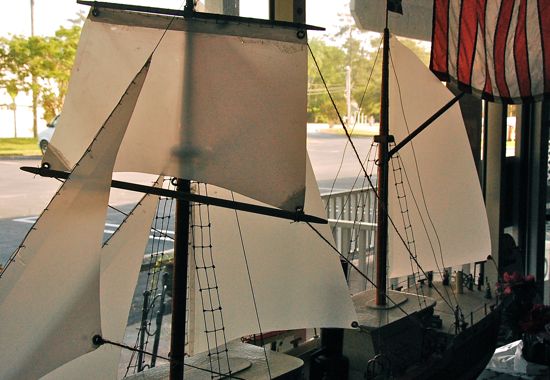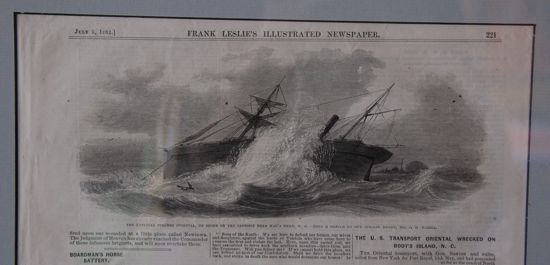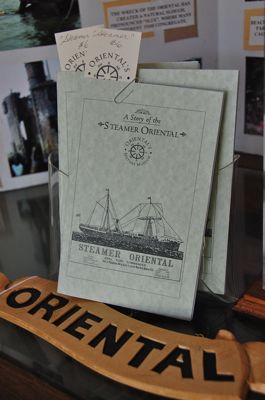It's Saturday November 8, 2025
May 4, 2012
Shipwreck. That’s the simple, one-word answer to the question that Oriental residents hear often, “What is the town of Oriental named for? Replica of the steamship, “Oriental” in the front window of the Oriental History Museum. The ship was powered by steam but had sails nonetheless. This model of the 200+ foot long ship was made by Jerome Parker and given to the museum a few years ago.
Replica of the steamship, “Oriental” in the front window of the Oriental History Museum. The ship was powered by steam but had sails nonetheless. This model of the 200+ foot long ship was made by Jerome Parker and given to the museum a few years ago.If a steamship delivering soldiers and supplies for the Union hadn’t gone aground and sank off of the Outer Banks during the Civil War, we might not be the town with the odd name that we are today.
150 years ago this month, the steamer “Oriental” was on its way from New York to South Carolina, but it didn’t get past a sandbar near Bodie Island. That was on May 16, 1862.
 Portlight from the original steamer, “Oriental” as presented to the Town by the NC Department of Cultural Resources Underwater Archaeology Unit.
Portlight from the original steamer, “Oriental” as presented to the Town by the NC Department of Cultural Resources Underwater Archaeology Unit.A few decades later, and 100 miles away, this community on the banks of the Neuse at the meeting of Smith and Greens Creek was needing a name. Which is when one resident, Outer Banks native Rebecca Midyette, recalled the shipwreck from her younger days.
That is how that sinking became part of our history, which the Oriental History Museum is commemorating on this 150th anniversary. The Museum is holding a Shipwreck Party from 11a-1p on Saturday May 5 — rootbeer floats are served — and welcomes the public to see its exhibits about the ship including a portlight taken from the wreck, and newspaper accounts from the time, and models of the ship and its boiler (some of which still protrudes from the waters just off the beach at Bodie Island).
Also on display will be a collection of compasses from around the world. It was a navigational error — and not an encounter with the enemy — that caused this Civil War sinking. The Museum a few months ago asked if area residents had compasses they’d be willing to loan and several came through with compasses that had stories of their own. They will be on display for two months.
 Collection of compasses at the Oriental History Museum. Area residents responded to a call out from the Museum. A compass error may have contributed to the sinking of the Oriental. Arguably, without that sinking the town of Oriental may not have gotten that name.
Collection of compasses at the Oriental History Museum. Area residents responded to a call out from the Museum. A compass error may have contributed to the sinking of the Oriental. Arguably, without that sinking the town of Oriental may not have gotten that name.Sharon Breitling of the Oriental History Museum says that the displays at the museum may help people — visitors and residents alike — “learn a little bit more” about the link between the sunken boat and Oriental, the town that bears its name. “People vaguely know the story but not a lot of the story,” she says.
More Of The Story About The Steamship “Oriental”.The “Oriental” had been built by Neafie & Levy boatworks for the Nuevitas and Cuba Steamship Company. She was first slipped in to the water in 1861. The steel ship was designed for the sugar trade between the US and Cuba. It was named for a town in Cuba. But it never went to the island.
Oriental History Museum President Lou Ostendorff has spent recent years doing extensive research on the “Oriental”. He says that just as the “Oriental” was being provisioned for its first trip to Cuba, it was, in effect, drafted. The Secretary of the Navy, says Lou, “chartered every merchant ship they could find to build up Mr. Lincoln’s Navy, and the “Oriental” was one of them.” The US Army rented the 218-foot long steamer for $1000 a day.
From Sugar Boat to Supply VesselLou Ostendorff says that “The Navy hastily converted the “Oriental” to a troop carrier with a secondary mission as a cargo ship.” IT ran one mission to Key West in early 1862. Its second mission was to go from New York to Port Royal, South Carolina. On board, says Lou Ostendorff, were “General Saxton and his compliment of soldiers as well as civilians trained and ready to help the Freedmen — freed slaves — start to run their own plantations and set up a provisional government now that the Confederates had been defeated at Port Royal.” Also on board were 30,000 letters to Union soldiers.
The “Oriental” left New York on May 15, 1862.
A Question About The CompassBefore the “Oriental” left New York, her compasses had been “swung” or checked for accuracy. This was common practice and especially important on a steel ship which could throw off the magnetically-oriented compasses. In harbor, the ship would be pointed in a direction known to be north and its compass checked to see if it aligned, and if not, by how much. Knowing the deviation, a captain could then compensate when taking compass bearings. The “Oriental” left New York, its compasses newly swung.
But Lou Ostendorff says that the new captain, Benjamin J. Tuzo had doubts about the accuracy. He was the son of the “Oriental’s” original captain who’d recently died, and Ostendorff says the new captain Tuzo was heard to have remarked, “I wish they had left my compass alone”.
“He was concerned that his recent compass adjustment caused him to steer in a westerly direction (toward the coast) in an effort to compensate for what he thought was a deviation problem.” Ostendorff says. “The rest is history.”
 A drawing of the “Oriental” aground and being pummelled by waves which appeared in Frank Leslie’s Illustrated Newspaper.
A drawing of the “Oriental” aground and being pummelled by waves which appeared in Frank Leslie’s Illustrated Newspaper.To complicate matters, there was a storm. To what degree the storm or the compass questions contributed may be an open question. The result is that the keel of the “Oriental” found the shoal waters off of Bodie Island and couldn’t float free.
 A contemporary account in Frank Leslie’s Illustrated Newspaper.
A contemporary account in Frank Leslie’s Illustrated Newspaper.Lou Ostendorff says news accounts at the time reported that cargo was pitched overboard — ammunition, oats, fresh water, raisins — to lighten the load and make the “Oriental” float. To no avail. All on board got off safely and there were no deaths. But the ship was wrecked by the ocean forces.
Part of the “Oriental’s” boiler sticks up out of the water and is still visible, 150 years later, from the shore at Bodie Island. It’s become a popular place for divers, and for fish. Along with the other displays about the steamer “Oriental” visitors to the museum can see a montage of photos of what the boiler looks like today.
 The Oriental History Museum has a display about the steamer “Oriental.” Admission is free and the museum is open Friday, Saturday and Sunday. The museum also sells booklets about the history as well as t-shirts and other gifts. It all goes toward upkeep of the museum which doesn’t get any funds from government.
The Oriental History Museum has a display about the steamer “Oriental.” Admission is free and the museum is open Friday, Saturday and Sunday. The museum also sells booklets about the history as well as t-shirts and other gifts. It all goes toward upkeep of the museum which doesn’t get any funds from government.